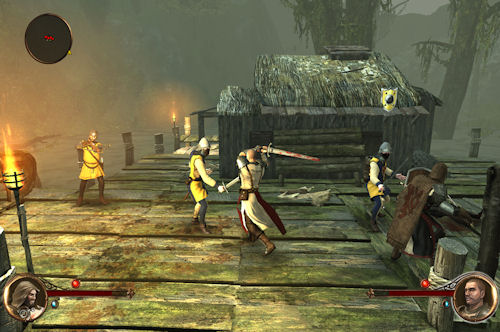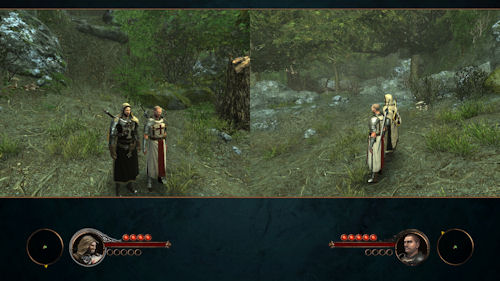
I’ve spoken of being able to switch to your companion character, which is nice, especially since your partner will be more interesting than the standard sword-and-board wielding Celian. Roland is an expert swordsman with a fair bit of swagger, while Marie dual-wields daggers, which she can also expend Zeal to throw. You can give simple commands to them, such as telling them to stay put while you navigate a trap-laden hallway or if you need ‘em to stand near a lever to solve a puzzle. Useful as that is, I’d rather the puzzle solving be assisted by companion AI outside of co-op (think Uncharted 2), since you’ll be bouncing between characters constantly just to toggle an obviously placed switch.
Though none of the pieces are masterworks of gameplay, they add up to a more compelling whole. Despite the fact that the entire world appears to be populated by thousands of clones of approximately seven people (including our heroes), and that accents are played fast and loose, the game manages to simply be fun to play.
The co-op support in The First Templar is surprisingly thorough, especially for a PC title. For online play you have the usual options, including drop-in/drop-out support. Each time you load up your game you’ll have the option to set online visibility for people to join up, be they friend or random encounter. In addition to the Kalypso account you’ll be making to play online, you have the interesting option to link your Facebook account to the game, allowing you to troll your friends for co-op sessions.

Splitscreen play is handled incredibly well - rather than simply split the screen in half and give each player an odd aspect ratio to play in, the screen is split into two 4:3 images, with the UI helpfully out of the way of the action. Impressively, as with the online play, splitscreen can be started or stopped at any time, which is a relative rarity and even more so on a PC.
With the exception of a handful of fights that are one-on-one duels, the entire game can be played in co-op, and the puzzle segments are definitely less annoying when you don’t have to constantly swap characters just to pull switches. Just like the single-player, you have the option of swapping who controls which character by tapping the tab key - your partner will have to confirm the request, but it flows about as smoothly as you’d want it to.
So it seems we have a paradise of co-op in The First Templar, but not everything is wine and roses, at least as far as online play goes. We were never able to get an in-progress campaign loaded in co-op until we started a fresh one with online visibility toggled on from the start. We also ran into an incredibly amusing bug that caused all doors/gates to appear shut to the second player. The only way to pass these nefarious obstacles was to swap characters and let the host run through the open doors. While funny the first few times, it really hampered our play session.

Though it may be a bug, the guest player also appears to be locked out of assigning experience points in their skill trees, despite the menu option being available to them.
Our advice: play it in split-screen if you can. Gamepads are supported out of the box, and if you have a wired 360 controller (or just one hooked up to your PC), the controls map exactly as they do on the console version. You can have one player on the keyboard and another on a gamepad if you like. It’s all good, The First Templar WANTS you to play it in co-op!
The First Templar is one of those games that you really dig despite itself. It’s not the prettiest girl in school, and it’s not a particularly deep experience, but there’s an earnest feeling to the whole affair, and come on: who doesn’t enjoy questing for the Holy Grail, especially with a friend? If it’s good enough for Indiana Jones, it’s good enough for us.
Verdict
Co-Op Score
Overall
The Co-Op Experience: Players take control of either a French Templar, or his companion, a noble lady who has been proclaimed a heretic.Fast-paced cooperative play: players can assist one another as each takes on the role of the game's key characters. Drop-in/out cooperative gameplay lets the AI take over when one player leaves the game
Co-Optimus game reviews focus on the cooperative experience of a game, our final score graphic represents this experience along with an average score for the game overall. For an explanation of our scores please check our Review Score Explanation Guide.